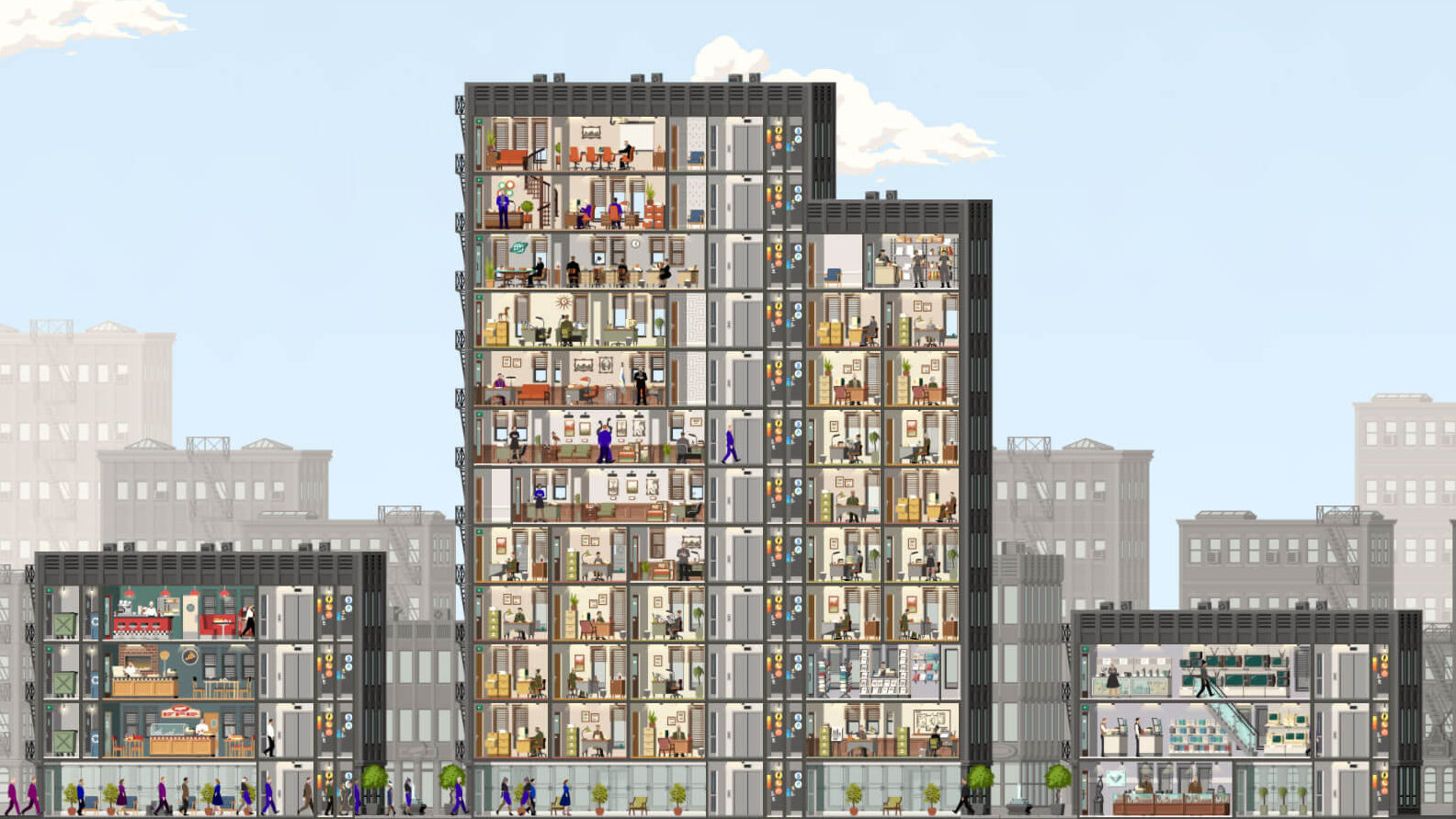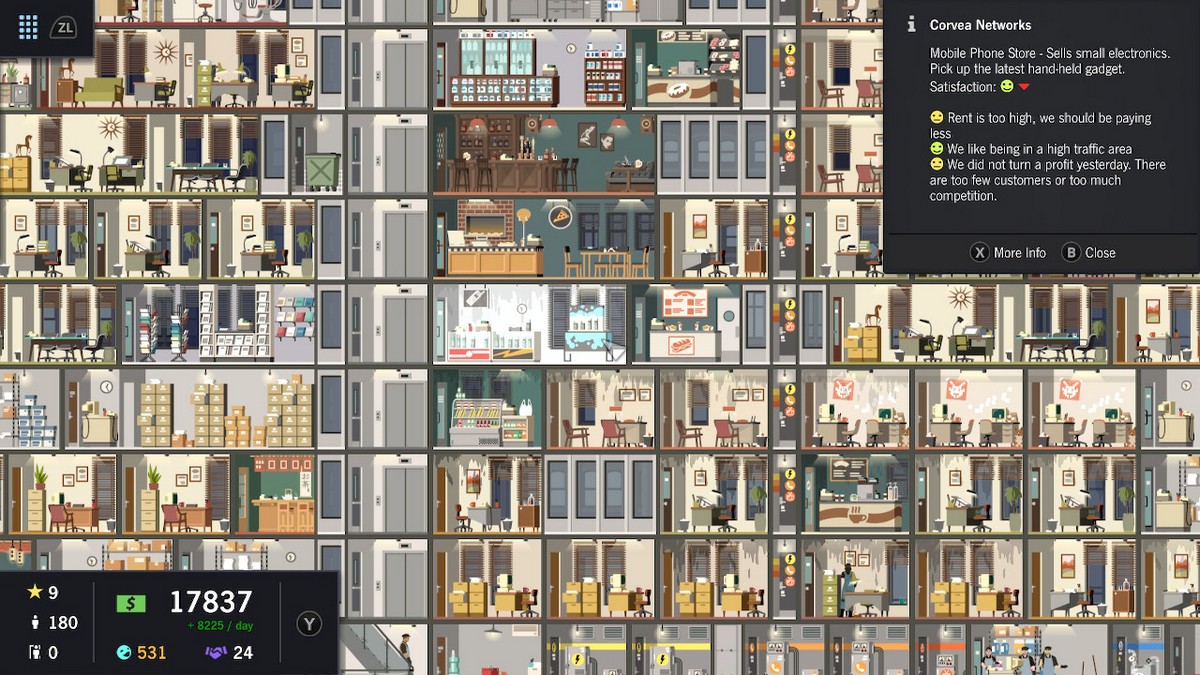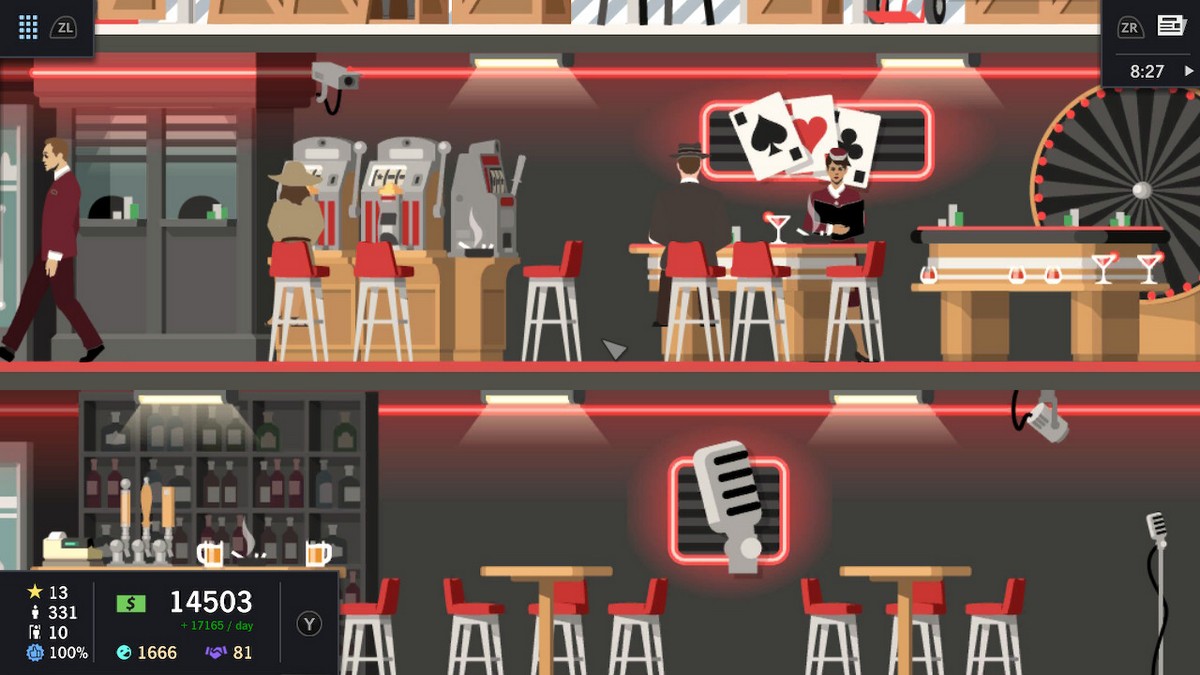Project Highrise: Architect’s Edition Switch Review
Sim-ply the best?

My first foray into skyscraper megalomania isn’t off to a great start. I’ve big aspirations of constructing a towering monolith of city flats, exuberantly tall and decked out with eateries and other amenities to keep my residents happy. But just a few stories up, my plan is already unravelling before my eyes.
I want it as tall as can be, so I’m stacking new floors on top at every opportunity. And I may as well future-proof it by foregoing stairs for elevators and fitting in all the infrastructure right away – plumbing, phone lines, cable TV. My bottom line ain’t looking too hot, though. Better take out a credit card. Then a bank loan. Now my credit is maxed out and I’m still in the red. Damn it.
If there’s one thing I’m learning about Project Highrise: Architect’s Edition, it’s that careful foreplanning and frugality pay off.

Project Highrise first released for PC in 2016. Architect’s Edition is a comprehensive console port of the tower-building sim, including all previous updates and DLC. I’m playing the Switch version, which I can’t help but feel is where the game truly feels at home.
After my disastrous efforts at residential property construction, I’m starting again and switching tack to commercial offices. Who needs houses, anyway? With harsh lessons learned, I’m starting slow and simple. For starters, those lard-asses are taking the stairs. And because each new floor requires its own infrastructure, I’m building my skyscraper wide, maximizing horizontal floor space, before shooting for the sky.

It works, and the difference is like night and day from my dreadful first attempt. In time, I’m building bigger and more prestigious offices, all with exponentially increasing demands. There are basic service requirements, like janitorial staff, rubbish collection and copy services. Infrastructure needs like cable TV and satellite. And different sectors are picky about logistics and location. Creative businesses want to get their heads down and concentrate without the disruption of noisy neighbours – a posh department store, on the other hand, will complain if situated next to smelly trash bins or curry houses.
It’s a lot to think about, and it keeps Project Highrise from being more than just a mindless game of growing your bank account and floor numbers. Every tenant has a happiness rating, suspended in a fine balance. While there’s a lot to do to raise this – meet all their needs, decorate the surrounding area or even lower their rent if you need to – there’s even more that can make it plummet. Let an office fall into disrepair or just one of their services lapse and a scowling face icon indicates that they’re at risk of moving out imminently – so you can kiss your rent money goodbye.

As a management sim, however, it’s not too demanding. Although there can become a complex web of infrastructure and hierarchical demands, the gradual pace at which you put everything together helps keep track of what’s what. You can pause or fast-forward time, too, for when you need time to fix a problem or are in a hurry for your next development to finish building. A whole host of financial reports and visual heatmaps help you make sense of everything from your utility outgoings to the levels of noise pollution in your building.
It’s in this minutiae that Project Highrise’s PC origins present themselves, however. The UI is host to a dizzying array of options, with menus within menus and tabulated content making it take a while for you to learn your way around. Every single button on the Switch has been used for something, in lieu of keyboard hotkeys and fine mouse control. It works, and is probably the best solution without having dramatically reworked the UI from the PC version, but it’s a lot to take in. Little niggles present themselves, like having to use the analogue stick for all movement and menu selection, even when the D-pad would be easier and more precise – because the D-pad is mapped to game speed.

With time, it all comes together, however. Hours in, I’m still picking new things up and learning valuable lessons, but my confidence as an architect has sky-rocketed. I’m completing city contracts left, right and centre – self-selected missions which offer hefty rewards for attracting enough residents or meeting a quota of building types. These provide some valuable direction in what could have otherwise been an aimless, never-ending sandbox. And having completed my fair share of office-based quests, I set my sights on something new: the hospitality biz.
This is where I delve into the extra content afforded by the Architect’s Edition, building a hotel and entertainment plaza of bars, restaurants and casinos atop my now sizeable estate. With content packs for Las Vegas, Miami Malls, Tokyo Towers, London Life and Brilliant Berlin included in the package, there are a variety of industries you can branch out into – and there’s nothing to stop you mixing and matching them all within one tower. One thing’s for sure: Project Highrise undoubtedly feels like a stronger, more well-rounded offering now than it must have done when it released as just the base game a couple of years ago.

My new venture brings its own set of challenges, like providing ample air conditioning for my luxe hotel rooms and installing new, wide service elevators to allow my staff to cart around their trolleys. A reviews system also comes into play, in which you have to closely monitor customer feedback to see how to improve. It’s both a strength and a weakness, however, that none of the sectors ultimately feels drastically different from one another. It all boils down to meeting a checklist of requirements for each room type and making sure those needs are maintained.
Just as a troublesome situation can trap you in a downwards spiral, like with my ill-fated residential block, once you have a base of profitable tenancies, resource management becomes a cinch – on normal difficulty, at least. Though I’m playing it safe with a single, fat tower, there’s scope to get creative with more interesting (and less efficient) designs. You could construct two or three separate towers, for instance, and connect them mid-air with skybridge walkways. And basic decoration is generously free of charge, so you can truly put your stamp on every building.

That said, Project Highrise is far from a visually exciting simulation, with simple, mostly static stock-like illustrations representing your tower. A more characterful approach would have injected some much-needed personality into the affair; though, the flipside is that the workmanlike aesthetic runs near-flawlessly on the Switch in both docked and handheld modes.
Project Highrise: Architect’s Edition is a solid offering. You’ve easily got tens of hours’ worth of content here – I’ve not even touched on the pre-built scenarios offering a variety of structured challenges in addition to the endless sandbox mode. The pleasing ‘kerching!’ of your daily income makes it frighteningly easy to while away the hours in a just one more floor mindset. It ain’t the prettiest or most sophisticated sim, and there’s a learning curve involved, but any budding architect would be well served by this comprehensive package.
